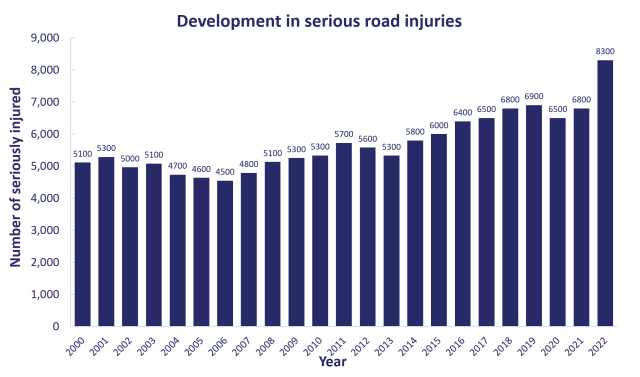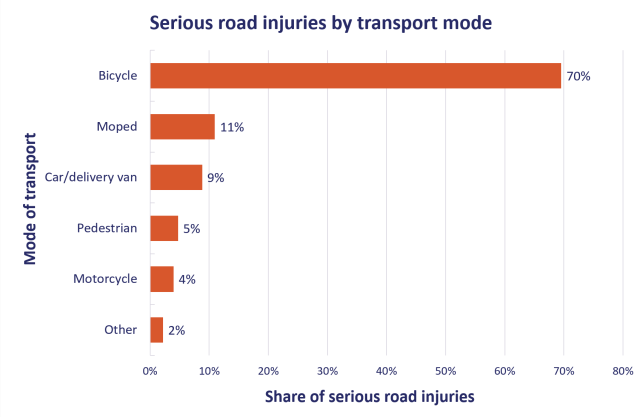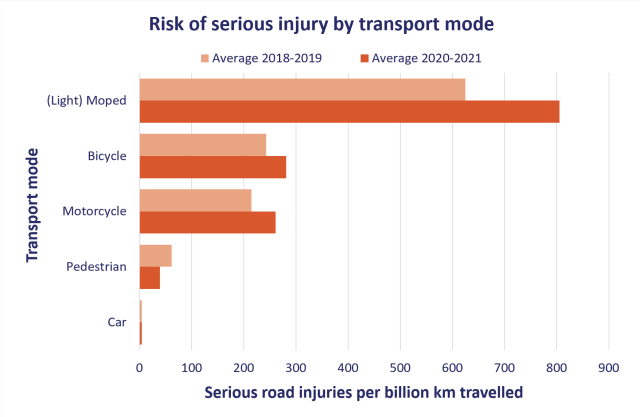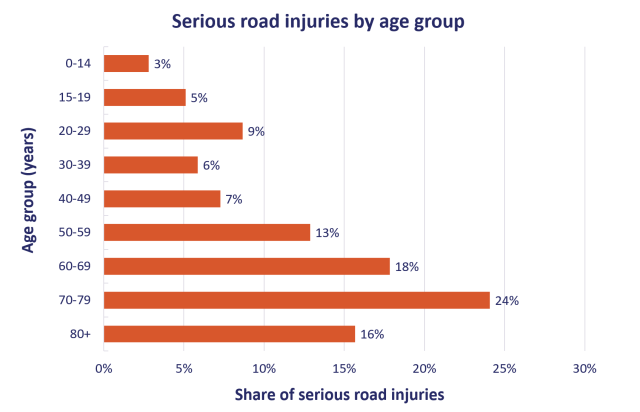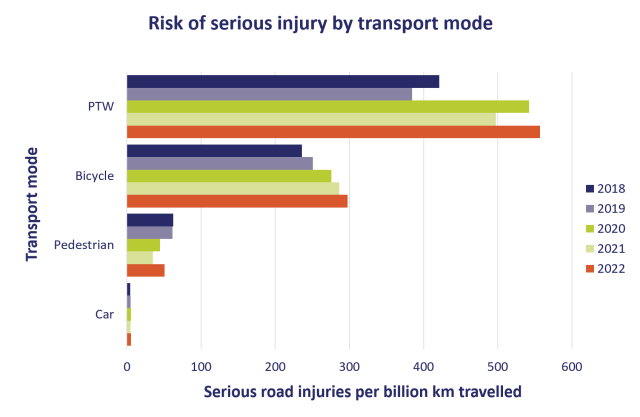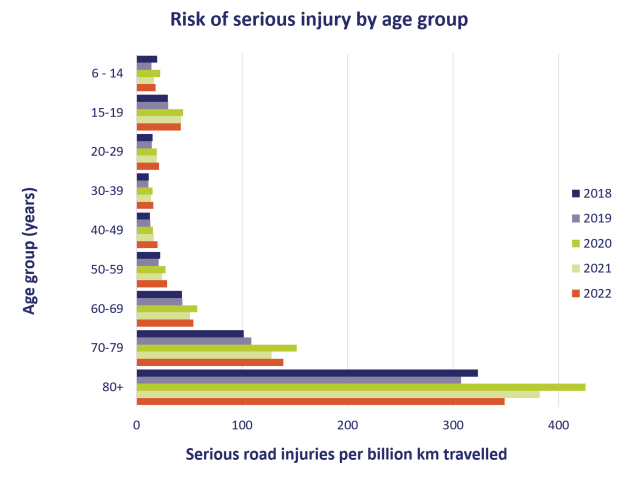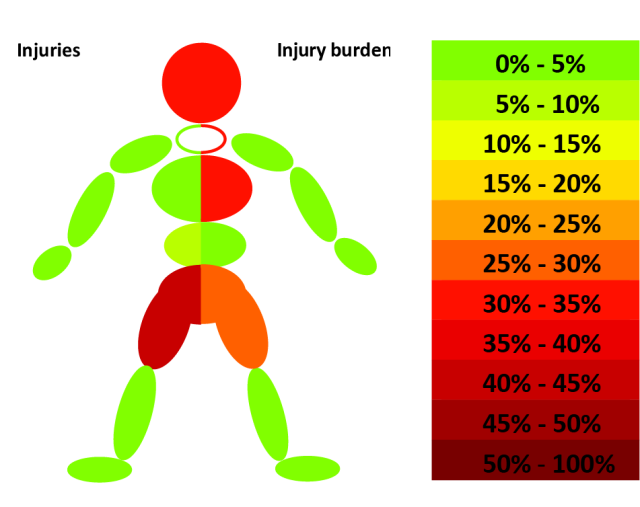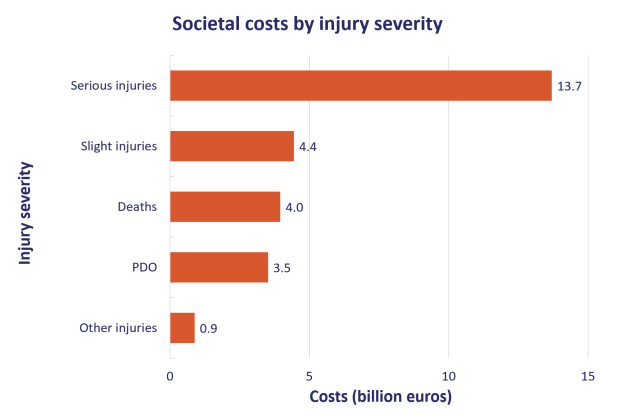Below you will find the list of references that are used in this fact sheet; all sources can be consulted or retrieved. Via Publications you can find more literature on the subject of road safety.
[1]. Bos, N.M., Bijleveld, F.D., Decae, R.J. & Aarts, L.T. (2023). Ernstig verkeersgewonden 2022. Schatting van het aantal ernstig verkeersgewonden in 2022 [Serious road injuries 2022. Estimate of the number of serious road injuries in 2022]. R2023-13. [Summary in English]. SWOV, Den Haag.
[2]. Oude Mulders, J., Aarts, L.T., Decae, R.J., Bos, N.M., et al. (2023). De staat van de Verkeersveiligheid 2023. Sterke stijging in aantallen doden en gewonden. R-2023-12. [English summary available in SWOV report Backgrounds of the State of Road Safety 2023; The annual monitor]. SWOV, Den Haag.
[3]. Stam, C. (2023). Letsels 2022. Kerncijfers LIS. Rapport 969. VeiligheidNL, Amsterdam.
[4]. Reusken, A., Beek, V. van de & Krüsemann, E.J.Z. (2023). Traumazorg in beeld. Landelijke traumaregistratie 2018-2022. Rapportage Nederland. Landelijk Netwerk Acute Zorg.
[5]. Bos, N.M., Bijleveld, F.D., Decae, R.J. & Aarts, L.T. (2022). Ernstig verkeersgewonden 2021. Schatting van het aantal ernstig verkeersgewonden in 2021 [Serious road injuries 2021. Estimate of the number of serious road injuries in 2021]. R-2022-11.[Summary in English]. SWOV, Den Haag.
[6]. Aarts, L.T., Broek, L.J. van den, Oude Mulders, J., Decae, R.J., et al. (2022). De Staat van de Verkeersveiligheid 2022. Trend in aantal verkeersdoden en -gewonden daalt niet. R-2022-10. [English summary available in SWOV report Backgrounds of the State of Road Safety 2022. The annual monitor]. SWOV, Den Haag.
[7]. Harbers, M.G.J. (2022). Maatregelen Verkeersveiligheid. Brief van de minister van Infrastructuur en WaterstaatMinisterie van IenW. Accessed on 22-12-2022 at https://www.tweedekamer.nl/kamerstukken/detail?id=2022D49193&did=2022D49193
[8]. Reurings, M.C.B. & Bos, N.M. (2011). Ernstig verkeersgewonden in de periode 1993-2009. Update van de cijfers [Serious road injuries in the period 1993-2009. Data update]. R-2011-5.[Summary in English]. SWOV, Leidschendam.
[9]. States, J.D. (1969). The Abbreviated and the Comprehensive Research Injury Scales. Proceedings of the 13th Stapp Car Crash Conference, SAE International.
[10]. Reurings, M.C.B. & Bos, N.M. (2009). Ernstig gewonde verkeersslachtoffers in Nederland in 1993-2008. Het werkelijke aantal in ziekenhuizen opgenomen verkeersslachtoffers met een MAIS van ten minste 2 [Seriously injured road crash casualties in the Netherlands in the period 1993-2008. The real number of in-patients with a minimum MAIS of 2]. R-2009-12. [Summary in English]. SWOV, Leidschendam.
[11]. Rijkswaterstaat (2018). Eindrapport kwaliteitsverbetering informatieketen verkeersongevallenregistratie. Rijkswaterstaat, WVL, Utrecht.
[12]. CBS (2020). Hoeveel reist de Nederlander en hoe? CBS. Accessed on 18-11-2020 at https://www.cbs.nl/nl-nl/visualisaties/verkeer-en-vervoer/personen/mobiliteit.
[13]. Aarts, L.T., Wijlhuizen, G.J., Hermens, F. & Bos, N.M. (2020). Koppelmogelijkheden van ambulancedata met andere bronnen. R-2020-15. SWOV, Den Haag.
[14]. Aarts, L.T. & Dijkstra, A. (2018). DV3 - Achtergronden en uitwerking van de verkeersveiligheidsvisie. De visie Duurzaam Veilig Wegverkeer voor de periode 2018 – 2030 onderbouwd [Sustainable Safety version 3 – Backgrounds and elaboration of the updated road safety vision. Substantiation of the second advanced Sustainable Safety vision for the period 2018-2030]. R-2018-6B. [Summary in English]. SWOV, Den Haag.
[15]. Aarts, L.T., Commandeur, J.J.F., Welsh, R., Niesen, S., et al. (2016). Study on serious road traffic injuries in the EU. European Union, Belgium.
[16]. Weijermars, W.A.M., Bos, N.M. & Stipdonk, H.L. (2014). Lasten van verkeersletsels ontleed. Basis voor een nieuwe benadering van verkeersveiligheid. R-2014-25. SWOV, Den Haag.
[17]. Wijnen, W. (2022). Maatschappelijke kosten van verkeersongevallen in Nederland. Actualisatie 2020. In opdracht van het Kennisinstituut voor Mobiliteitsbeleid KiM. W2Economics, Utrecht.
[18]. Ministerie van IenW, Ministerie van JenV, IPO, VNG, et al. (2018). Veilig van deur tot deur. Het Strategisch Plan Verkeersveiligheid 2030: Een gezamenlijke visie op aanpak verkeersveiligheidsbeleid. Ministerie van Infrastructuur en Waterstaat, Ministerie van Justitie en Veiligheid, Interprovinciaal Overleg (IPO), Vereniging van Nederlandse Gemeenten (VNG) , Vervoersregio Amsterdam en Metropoolregio Rotterdam Den Haag (MRDH), Den Haag.
[19]. Tweede Kamer (2021). Motie van het lid Geurts over een halvering van het aantal verkeersslachtoffers in 2030. Maatregelen verkeersveiligheid 29 398, nr. 946. Tweede Kamer der Staten-Generaal. Accessed on 17-02-2023 at https://www.tweedekamer.nl/kamerstukken/moties/detail?id=2021Z13389&did=2021D28533
[20]. Craen, S. de, Bijleveld, F.D., Bos, N.M., Broek, B. van den, et al. (2022). Kiezen of delen. Welke maatregelen kunnen zorgen voor halvering verkeersslachtoffers in 2030? R-2022-8. [English summary available in SWOV report A 50% reduction in road casualties by 2030? Calculating the effect of additional measures] SWOV, Den Haag.
[21]. Ministerie van IenM (2012). Structuurvisie infrastructuur en ruimte. Nederland concurrerend, bereikbaar, leefbaar en veilig. Ministerie van Infrastructuur en Milieu, Den Haag.
[22]. Aarts, L., Wijlhuizen, G.J., Gebhard, S., Goldenbeld, C., et al. (2021). De Staat van de Verkeersveiligheid 2021. Doelstellingen voor 2020 definitief niet gehaald – hoe nu verder? R-2021-21.[English summary available in SWOV report Backgrounds of the State of Road Safety 2021. The annual monitor]. SWOV, Den Haag.
[23]. United Nations (2020). Improving global road safety. A/74/L.86. United Nations, New York.
[24]. Council of the European Union (2017). Council conclusions on road safety: endorsing the Valletta Declaration of March 2017. Outcome of Proceedings from the General Secretariat of the Council. 9994/17 / TRANS 252 / 8666/1/17 REV 1 TRANS 158. Council of the European Union, Brussels.
[25]. Cleij, D. (2021). Road safety thematic report – Advanced driver assistance systems. European Road Safety Observatory, European Commission, Brussels.
[26]. EC (2016). Road Safety: new statistics call for fresh efforts to save lives on EU roads. European Commission. Accessed on 14-11-2022 at https://ec.europa.eu/commission/presscorner/detail/en/IP_16_863.
[27]. EC (2020). 2019 road safety statistics: what is behind the figures? European Commission, Brussels. Accessed on 02-10-2020 at https://ec.europa.eu/commission/presscorner/detail/en/QANDA_20_1004.

